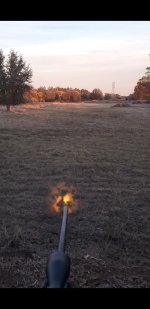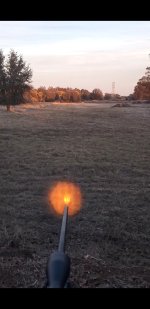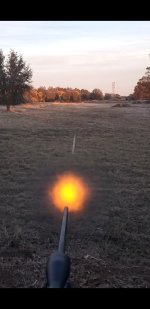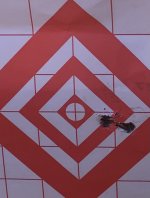You are using an out of date browser. It may not display this or other websites correctly.
You should upgrade or use an alternative browser.
You should upgrade or use an alternative browser.
Hammer Trail applicator kit
- Thread starter Steve Davis
- Start date
Here's a few stills, in order.Now that is a Hammer Trail. Not trace.
@MeatBuck
This trail/smoke started just past what i would call concusion dome



Not really sure on fast or slow?Very cool, and interesting when considering the timing of the bullet release and the concussion dome. I wonder if most powders exhibit this, or if there s a difference between fast and slower burning powders?
But this was with w760. A Full case.
Now honestly I don't know is it vapor/super heated oil/smoke/atmospheric anomaly?
What ever it is, I can definitely say it's freaking cool!!!
BFD
Hammer Time Executive member
I’m gonna SWAG:Not really sure on fast or slow?
But this was with w760. A Full case.
Now honestly I don't know is it vapor/super heated oil/smoke/atmospheric anomaly?
What ever it is, I can definitely say it's freaking cool!!!
- Trace/vapor is what we see on all bullets
- I don’t think enough heat generated in flight to cause smoke from burnt oil, because there’s no burnt oil smell. I’ve had the Hammer trail waft around me and the gun momentarily and no burnt oil smell.
- it’s atmospheric and off gassing of the oil.
joevh
Hammer Time Executive member
I've been following this thread with interest, and have been curious about the Hammer trail for over a year now. I flew Navy fighters for 10 years, and now commercial jets for 27 years, so I'm pretty familiar with contrails and 'vapes' coming off of the wings. Contrails are formed from the heat of the engine exhaust reacting with the environmental conditions; they can come and go at different altitudes (usually more present at higher altitudes) and last a fair while, which makes sense, as the engines create a rather large disturbance in the atmosphere.
'Vapes', as we called them, would be white vapor above the wing of the jet at high speed, particularly under g-load in humid climates, such as coming in for the break to land. This is caused from the low pressure on top of the wing due to the camber of the wing that accelerates the airflow and creates lift. Vapes are super short-lived; basically present just above the wing, as the low pressure condition immediately dissipates behind the aircraft.
I have seen many hammer trails through slow-motion video, but have not personally seen them live from a shooter's perspective, as they are very short-lived. I think the general consensus is that they have somewhat diminished after the Hammer boys started sucking out the remaining production oil. Just tonight, upon thinking about it, my latest idea is that perhaps some of the trail is coming from smoking oil (I doubt if any person has a good enough nose to smell a microscopic amount of oil burning that strarts 30' in front of them) and a larger part of the trail comes from vapes. These 'vapes', as I call them, could very well come from the airflow rising up over a PDR band, creating a low pressure area much like the camber of a wing. This would explain their super short duration, why they are dependent upon environmental conditions (mostly humidity), and why Hammer bullets demonstrate them more than other bullets. Most bullets don't have grooves (except maybe a cantilever, which wouldn't do much except create some turbulence), except the Other Brands of solid copper, but they are not smooth PDR bands. Rather, their square cut grooves are probably going to be more likely to create turbulence than the laminar airflow that would create a low pressure area and a small vapor cloud.
I'm not an engineer, not a physicist, and not a meteorologist. I may be all off base, but this is my latest speculation.
'Vapes', as we called them, would be white vapor above the wing of the jet at high speed, particularly under g-load in humid climates, such as coming in for the break to land. This is caused from the low pressure on top of the wing due to the camber of the wing that accelerates the airflow and creates lift. Vapes are super short-lived; basically present just above the wing, as the low pressure condition immediately dissipates behind the aircraft.
I have seen many hammer trails through slow-motion video, but have not personally seen them live from a shooter's perspective, as they are very short-lived. I think the general consensus is that they have somewhat diminished after the Hammer boys started sucking out the remaining production oil. Just tonight, upon thinking about it, my latest idea is that perhaps some of the trail is coming from smoking oil (I doubt if any person has a good enough nose to smell a microscopic amount of oil burning that strarts 30' in front of them) and a larger part of the trail comes from vapes. These 'vapes', as I call them, could very well come from the airflow rising up over a PDR band, creating a low pressure area much like the camber of a wing. This would explain their super short duration, why they are dependent upon environmental conditions (mostly humidity), and why Hammer bullets demonstrate them more than other bullets. Most bullets don't have grooves (except maybe a cantilever, which wouldn't do much except create some turbulence), except the Other Brands of solid copper, but they are not smooth PDR bands. Rather, their square cut grooves are probably going to be more likely to create turbulence than the laminar airflow that would create a low pressure area and a small vapor cloud.
I'm not an engineer, not a physicist, and not a meteorologist. I may be all off base, but this is my latest speculation.
Last edited:
JesseJ
Hammer Time Executive member
But you did stay at a holiday inn express last night.I'm not an engineer, not a physicist, and not a meteorologist. I may be all off base, but this is my latest speculation.
What you said, I’ve been thinking, for a while now.
@joevh that’s about what I have been thinking all along but just didn’t have the verbiage in my vocabulary to articulate it that well! Nor honestly have I much cared, I never have seen the trail but I typically shoot alone and have never actually watched someone else shoot a hammer.
Main thing I care about is that they kill and arrive on target with good accuracy!
Main thing I care about is that they kill and arrive on target with good accuracy!
Mountainman
Hammer Time Executive member
I believe this is very much what is happening but it seems either the oil accentuates the effect or vice versa. It also seems to work best with the HH design. The smoother PDR bands on the HHT's don't seem to do much although the larger hollow point without tip installed isn't exactly comparing apples to apples. I've also tried with other bullet manufacturers and had zero results with slick sided bullets. I did however have a slight visible trail with the other guys solid copper bullet that also has bands. This seems to indicate oil or pdr bands alone will not create the effect but rather it requires both.These 'vapes', as I call them, could very well come from the airflow rising up over a PDR band, creating a low pressure area much like the camber of a wing. This would explain their super short duration, why they are dependent upon environmental conditions (mostly humidity), and why Hammer bullets demonstrate them more than other bullets. Most bullets don't have grooves (except maybe a cantilever, which wouldn't do much except create some turbulence), except the Other Brands of solid copper, but they are not smooth PDR bands. Rather, their square cut grooves are probably going to be more likely to create turbulence than the laminar airflow that would create a low pressure area and a small vapor cloud.
I'm not an engineer, not a physicist, and not a meteorologist. I may be all off base, but this is my latest speculation.
One thing I will say, while they may be dependent on some environmental conditions I don't believe humidity has a lot to do with it. I have had very visible trails with the old HH bullets in very dry conditions (our humidity here is usually in the teens or even single digits). Since our humidity was a very high 70% when I tested on Wednesday I will wait for more desert like conditions before I test again. Perhaps Steve will chime in and give me some suggestions on what type of oil to use.
Not sure why I keep doing this. Like Carsyn22 said, the guy running the trigger never gets to see the trails and the dead critters never notice either but it is a crowd pleaser, especially at the range. They are fun when watching others shoot them as well. More likely just a stubborn old guy who wants to see if he can reproduce the effect.
BFD I am waiting on your tests also.
Regards
The real reason is "the challenge" to prove something none have duplicated with any success. Then the "Crowing" begins! 


kneedeep
Hammer Time Executive member
If you don’t think it’s humidity then maybe check the pressure and cloud cover.I have had very visible trails with the old HH bullets in very dry conditions (our humidity here is usually in the teens or even single digits).
kneedeep
Hammer Time Executive member
View attachment Hammer trails 1.mp4
I’ll post this video from a couple of years ago. I took it through a spotting scope with my iPhone while others were shooting. Overall it was a day with many trails but not all of the bullets/calibers were consistent.
I did not check to see how much oil fill was in these pills.
Notice the last video of the 6.5 The trail doesn’t start until it gets to around 400-450 yards. You can see the swirl and then see the trail kick in. This was also the highest velocity pill of the day.
What I find most interesting about these trails is the spiral or corkscrew pattern. From a few degrees offset of the shooter is the best location to see the spiral.
I’ll post this video from a couple of years ago. I took it through a spotting scope with my iPhone while others were shooting. Overall it was a day with many trails but not all of the bullets/calibers were consistent.
I did not check to see how much oil fill was in these pills.
Notice the last video of the 6.5 The trail doesn’t start until it gets to around 400-450 yards. You can see the swirl and then see the trail kick in. This was also the highest velocity pill of the day.
What I find most interesting about these trails is the spiral or corkscrew pattern. From a few degrees offset of the shooter is the best location to see the spiral.
JesseJ
Hammer Time Executive member
My 13 yr old has had a little run of bad luck. Smooth missed a very nice buck at 300 yrds a couple weeks ago, and 2 days ago, at 370 yrds, clipped a very nice buck in the leg. (No bone impact, deer will be fine). He’s already killed multiple critters (does and hogs) this year over 300 yrds. So my guess was buck fever. I let him make a couple shots today on the 300 yard target. Rifle on needed 1 click to correct so we will chalk it up to nerves being the reason for the misses. I was standing 15 yards to the side. Bright sun, very low humidity, 68 degrees. Check the hammer trail out.
View attachment IMG_6713.mov

View attachment IMG_6713.mov

Similar threads
- Replies
- 5
- Views
- 205
Share:

